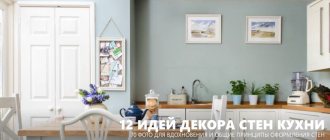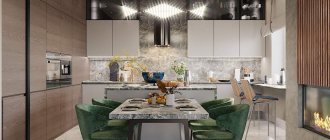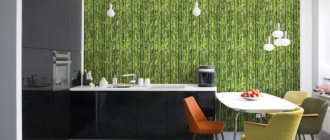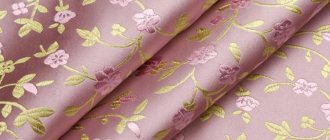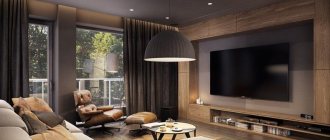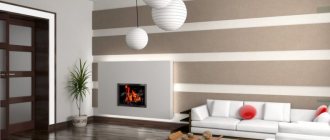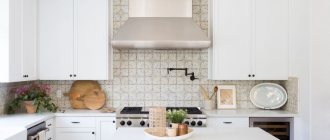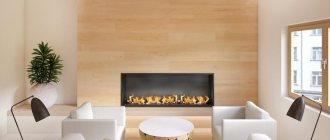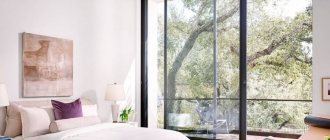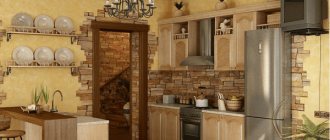Almost everyone, having started a kitchen renovation, thinks about how to decorate the walls in the kitchen in the apartment. The dilemma is related to the characteristics of the kitchen space: the walls are exposed to humidity, temperature changes, and there are microparticles of dust and grease in the air. And despite the presence of a hood, the operating conditions are still worse than in other rooms. Good news for those who have decided to update their kitchen interior - today the choice of durable and at the same time stylish coatings is quite large. Let's talk about each in more detail.
Features of wall decor in the kitchen
The room cannot boast of a good microclimate. Here the temperature can rise or fall sharply, humidity increase, juice begins to splash or fat begins to fly.
Therefore, the wall decoration should be ready:
- Withstand changes in temperature and humidity;
- Does not require complex maintenance, especially in the work area;
- Do not absorb odors and fat;
- Do not become a breeding ground for bacteria.
It should also complement the existing interior and please the owners.
Ceiling
Finishing the ceiling in the kitchen can be done in many ways: plasterboard and suspended ceilings, foam boards, plastic panels, painting. Wallpapering the kitchen is the easiest, low-budget and fastest option. Even if for some reason the appearance of the wallpaper deteriorates, gluing new ones will not be difficult, unlike dismantling the same drywall. It is better to choose smooth wallpaper that will not accumulate dust and grease, and a coating of light shades will help to visually “raise” the ceiling. This finishing is simple and can be done independently.
Color spectrum
There are no special rules for choosing the color scheme of kitchen walls.
A home catering unit will look great with:
- Familiar white shades, increasing the existing volume and giving more light;
- Pastel colors that create warmth and comfort;
- Bright colors that stimulate the appetite and lift your spirits.
The colors of the green spectrum have become popular: mint, meadow, pistachio, and the color of unripe lemon.
In spacious rooms, you can use several colors at once to separate the dining and work areas.
In a small kitchen, a more elegant apron becomes a prominent spot, and all other surfaces are tried to be made just a background for the furniture. Space and tranquility will be provided by a completely monochromatic wall decoration, slightly diluted with a kitchen set.
Five design tips
- When choosing wallpaper and furniture, try not to overload the interior; one thing should be the emphasis. Combine spectacular bright wallpaper with laconic and simple kitchen facades, but for a catchy set with an intricate design you will need a neutral, calm background.
- When choosing a color scheme, not only the shade is important, but also its belonging to the color scheme . Warm shades should be combined with the same warm color “brothers”, cold shades should be combined with cold ones.
- When combining several types of wallpaper, choose one price category . The best solution is companion wallpapers belonging to the same manufacturer’s collection.
- Wallpaper with a pattern can be used to visually adjust the area of a room . Thus, vertical stripes are suitable for low kitchens, and horizontal stripes for narrow ones. To avoid getting bored with stripes, give preference to soft colors that gradually flow into each other.
- For a kitchen facing west or north, choose warm shades - yellow, cream, grass green, light peach, orange, apricot and light brown. For southern and eastern kitchens, pale blue, light green, blue, silver, and white are suitable.
Tile
Durable, durable and practical, tiles remain the most attractive material for kitchen decoration. She:
- Not afraid of moisture, temperature, cleaning, dirt;
- Does not absorb dust and odors;
- Can be easily washed with plain water and chemicals;
- Has many colors and patterns.
The entire room is rarely tiled; in this case, the kitchen will look too much like a catering establishment. Basically, durable material is used to decorate the cooking area.
If you want to make a very unusual design using a ceramic coating, then choose tiles with patterns. Most often, classic and ethnic interiors are decorated in this unusual way.
The disadvantage of tiles will be their high cost and the requirement to hire professional tilers.
No. 4. Glass: unusual and impressive
Glass has been used to decorate kitchen splashbacks not so long ago, but in vain. This is an excellent material that meets all the requirements for this zone. Glass panels with a pattern printed on them are also called skinali . They are made from thick tempered glass and decorated in various ways: by sandblasting, placing 3D polycarbonate material inside, or using ultraviolet printing. Sandblasting involves the impact of small abrasive particles on the surface of the glass under high pressure, as a result of which a relief three-dimensional pattern can be obtained, and for an even more spectacular result, some areas can be painted with colored enamels. Using UV printing, you can also obtain realistic, beautiful images, and apply any patterns and colors to glass.
The main advantages of this finishing method:
- high strength, because tempered glass is used, which is difficult to break, and even with a strong impact it is not capable of injuring anyone, because it shatters into fragments with blunt edges;
- practicality and ease of maintenance, resistance to aggressive detergents, while the appearance of the surface remains unchanged for many years;
- absolutely seamless coating, which ensures excellent hygiene, because dirt will not accumulate in the seams and microorganisms will not develop;
- unique appearance, because you can apply absolutely any image: be it fruit, a painting, or your own photograph.
As you can see, glass panels, or skinals, are distinguished by high performance and external characteristics, but are not yet used so often due to the high cost of the material and the work of organizing the apron in this way. Although the glass apron is easy to wash, you will have to do it regularly, because all splashes and stains are clearly visible on its surface . It will be very difficult to change the image if desired, and you will have to completely think through the interior in advance, because if it later turns out that you need to organize railing in the area of the work area, then this will not be possible. But a glass apron can be illuminated very effectively, and it will acquire a 3D effect.
Plastic panels
Another durable way to create the most unusual kitchen design is to use plastic panels. They can imitate marble, wood, frescoes, fabric or be extremely artificial, which is especially suitable for modern designs.
The advantages of this design are:
- Easy to clean;
- Calm attitude towards moisture, temperature, dirt, aromas;
- Easy installation;
- Low cost.
However, the coverage:
- It is not a very environmentally friendly material;
- It will take up space to create the sheathing;
- Accumulates moisture under the surface and therefore requires regular ventilation.
This type of finishing is especially in demand in spacious rooms designed in minimalist or high-tech style. In this case, choose plain glossy panels that expand the walls of the room and add light.
No. 6. PVC film - temporary solution
If you need to make quick and inexpensive temporary repairs, then it makes sense to take a closer look at PVC film. For a while, just before you do normal repairs, it can serve normally. Its main advantage is low cost . In addition, the range of colors of such films is simply huge: natural materials, landscapes, ornaments, etc. You can handle gluing such material yourself; the film is resistant to mechanical damage, but that’s where its advantages end.
This material can gradually fade under the influence of sunlight, it is afraid of high temperatures, and if damaged it cannot be restored. It can be used as a temporary kitchen decoration, but is not suitable for permanent use.
Wallpaper
The ancient method of wall decoration still remains popular. Wallpaper:
- They are low cost, easy to apply and remove;
- They have the largest possible number of patterns and color varieties.
This finish is perfect for any interior; it goes well with wood and its imitations, plaster, plastic, and paint.
The disadvantages of wallpaper are manifested in the relative fragility of the coating, which does not particularly like high humidity and temperature, splashes and other unpleasant moments of living in the kitchen space.
Paper sheets are especially susceptible to abrasion, non-woven fabrics feel better, and vinyl wallpapers are as calm as possible about all the nuances of life in the kitchen.
But foamed vinyl will not provide the opportunity to remove moisture from the walls, as a result of which mold may appear in the room, and soot will gradually accumulate in the relief patterns.
Fiberglass wallpaper will create an unusual design.
Such canvases:
- They are not afraid of absolutely any climate disasters;
- Can be repainted up to 10 times, quickly changing the mood of the kitchen;
- Wash with water and household chemicals.
But the high price of such a design stops most housewives from immediately purchasing this coverage.
No. 1. What materials can be used to finish the apron?
To all the requirements for the material of a kitchen apron described above, it is worth adding that it must have the smoothest possible surface and be low-porous . Due to this, the ability of the material to absorb moisture is reduced, and the ease of maintenance, on the contrary, increases.
Today, the following materials are used to organize an apron:
- ceramic tile;
- mosaic;
- glass;
- PVC panels;
- natural and decorative stone;
- MDF panels;
- metal;
- plaster, paint and other materials.
Each of these materials has its own advantages, disadvantages and features, and below we will dwell on the characteristics of each of them.
Wooden panels
Natural material will give the kitchen additional comfort and warmth. It is recommended to use it in spacious rooms in classic or rustic decoration, away from the cooking area. Wood:
- Has increased flammability;
- Doesn't like water;
- Does not tolerate washing;
- Absorbs odors and grease.
Special impregnations will slightly improve the characteristics of the coating, but even in this case the wood will require too much effort to maintain an attractive appearance.
No. 10. Metal: ideal for high-tech style
A metal apron will fit only into a modern-style interior . There are many advantages to such a solution: durability, resistance to fire and water, and chemicals . At the same time, you will have to put up with the fact that all the splashes , drips, and stains are clearly visible on the metal. They will need to be wiped regularly to ensure the coating looks perfect, but this is not that difficult, especially since you can get rid of dirt quite quickly.
The main disadvantage of this finish is its cold appearance, and there are very few possible colors. It is important to think through the interior of the kitchen very well so that such an apron looks truly organic and stylish. Moreover, this material reflects light very well, so you need to think through the lighting system so as not to end up with a room with an abundance of glare and sunbeams.
Cork
A nice material is cork, which is made from tree bark and has all the benefits of wood. She:
- Has an attractive appearance;
- Eco-friendly;
- Not susceptible to tree beetles;
- Not afraid of water;
- Does not absorb odors.
The finish is durable and practical, has excellent sound insulation properties, creates a cozy room, but is quite expensive.
Dye
The most ancient version of kitchen design will help to decorate the room in a familiar or unusual way.
Dye:
- Feels great in any climate change;
- Retains its attractiveness for a long time;
- Does not require hassle or worries.
If desired, a flat surface can be decorated with patterns or stickers, creating the most unique design. The material is perfect for any design style and any area.
Floor
In addition to the standard methods of floor design, the herringbone looks original - the tile layout resembles a parquet pattern. For such a pattern, a rectangular elongated floor tile without a colorful pattern is suitable.
“Labyrinth” or “braid” is a combination of rectangular and square tiles, and the dimensions of the tiles must be proportional. For this floor design, it is better to use tiles of different colors. Square tiles are covered on four sides with rectangular tiles, creating the impression of interlacing stripes, in the middle of which a square of a lighter or darker shade stands out. Examples of when this finish is used can be seen in the photo.
If the design of the floor in the kitchen occurs according to the residual principle, when after the renovation of other rooms there are a lot of different tiles left, then you can try to create a kaleidoscope. In order not to get confused in the prepared elements, you need to make a sketch of the desired ornament. You can also mark the floor surface, which will help you avoid mistakes during installation.
Plaster
Simple plaster is once again becoming a popular type of finish and a wonderful addition to any decor. She:
- It does not require special care;
- Not afraid of water and temperature changes;
- Relaxes with odors.
In addition to the usual white and gray plaster, today you can find finishes in almost any color, so that the kitchen space will become quite bright and memorable.
Decorative plaster will create the mood of an ancient castle or an original room decorated in the most unusual way. True, to create such an effect you will need the help of specialists.
Liquid wallpaper
Liquid wallpaper can replace plaster. Their additional benefits include:
- Easy to apply (they don’t even require very careful leveling of the walls);
- Creating a seamless surface;
- Ability to close the most inaccessible places;
- High maintainability.
And if necessary, the wallpaper can be removed and applied in another place.
Stone
Stone walls in the kitchen will create an atmosphere of ancient romance or a rough home of Alpine peasants. This effect is achieved due to the area of use of the stone and its shades.
The material can only be used in spacious kitchens and, preferably, only on one wall.
- For a long time, they used stone to decorate the area near the doors and near the stove, without completing the work a little. But today such design is going out of fashion, being replaced by a full-fledged decoration of an accent wall.
- The disadvantages of the stone are its weight, price and massiveness, which visually “eats” part of the available space. Decorative stone can correct this shortcoming, but when choosing this option you should pay special attention to high-quality imitation of natural material.
No. 11. How to organize a kitchen apron in an original way?
A kitchen apron can be finished with paint or plaster , naturally, with maximum water resistance, but if you cook something more or less often, then this option is not suitable, especially when it comes to light-colored finishes.
In addition to all the ways to organize a work wall described above, there are also a lot of unusual, creative options that will highlight your individuality and make your kitchen unique. Here are just a few of them:
- use broken and whole pieces of ceramic tiles and dishes . First you will need to lay out all the fragments on the floor or on the table, and then carefully mount them on the wall. It comes out stylish and original;
- remnants of parquet can also be useful. It is fixed on a sheet of moisture-resistant chipboard, for example, in a herringbone pattern, and a panel of transparent tempered glass is additionally mounted on top near the hob to protect the material in the most critical area;
- wine corks are an excellent option for organizing the space of a kitchen apron, however, you will need a lot of them - about 1000 for an apron 2 meters long. They can be cut in half lengthwise to be used more economically, and it will be easier to attach them this way. You can cut the corks crosswise and also get an original effect. It is better to glue them not on the wall, but on a sheet of moisture-resistant chipboard, in order to make the dismantling process easier in the future. Such an apron is covered with tempered glass in order to preserve the performance qualities necessary for the work area while maintaining the original appearance. Finding such a number of traffic jams is not as difficult as it seems: you can ask around in bars and restaurants or even look on notice boards;
- pebbles are an excellent alternative to granite and other types of stone, however, the installation process is quite troublesome, because each pebble will have to be leveled by hand;
- wallpaper . Using wallpaper in the kitchen work area seems crazy, but if you cover it with a glass panel, then everything falls into place. You can use any wallpaper, and the removable glass panel can be periodically removed and the covering changed: the kitchen interior can be updated very quickly. In the same way, you can hide a piece of fabric under the glass, which also looks very original;
- slate paint Great for the kitchen area, because it can be washed as much as you like, think of school boards. You can use chalkboard paint to paint part of the kitchen apron or the entire backsplash. In any case, in addition to a practical solution, you also get an original interior, because on such a surface you can write down recipes, reminders, draw pictures, etc.
Everyone, if they think a little, will be able to offer their own original version of finishing the kitchen apron, but the main thing is to make this area not only attractive, but also practical.
Brick
Brick walls will allow you to create a very original room. They look best on accent walls near the stove or dining table. In small rooms, preference is given to white or gray colors; in a spacious kitchen, a brown finish will also look nice.
Brickwork is great for period designs; this material is not used in modern designs.
Decorating the walls in the kitchen will be a fascinating process, and the resulting result, with the right choice of material, will delight the owners of the room for a long time.
No. 3. Mosaic: room for imagination
Using mosaics, you can create the most incredible patterns and even entire paintings. A kitchen apron can become a real work of art, and the performance characteristics of the mosaic are very good. Among the main advantages it is worth noting:
- moisture resistance;
- heat resistance;
- easy to care for and hygienic;
- strength;
- wear resistance and durability;
- unique appearance.
These are all the general characteristics of mosaics, because they can be of different types and made from different materials:
- ceramic mosaic repeats all the characteristics of ceramic tiles, only you can lay out any patterns from tiles measuring 2*2 cm;
- glass mosaic performs well in operation, as it is completely inert to moisture and fire. In addition, this material can change color slightly depending on lighting conditions, which makes it even more unique;
- stone mosaic is quite rare due to its high price, and caring for it is difficult;
- metal mosaic is quite durable and practical, but you can’t rely on a variety of shades and colors.
The disadvantages of mosaics include the complexity of the installation process and, in some cases, the cost. A perfectly flat surface is needed, and grouting should be done extremely carefully so that dirt does not accumulate in them. Otherwise, this is an excellent material for finishing an apron in the kitchen.
